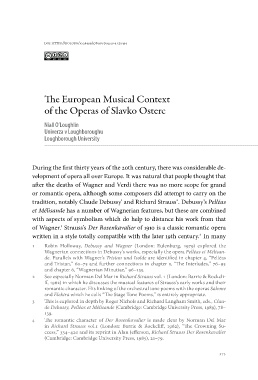Page 375 - Weiss, Jernej, ur. 2019. Vloga nacionalnih opernih gledališč v 20. in 21. stoletju - The Role of National Opera Houses in the 20th and 21st Centuries. Koper/Ljubljana: Založba Univerze na Primorskem in Festival Ljubljana. Studia musicologica Labacensia, 3
P. 375
oi: https://doi.org/10.26493/978-961-7055-50-4.373-394
The European Musical Context
of the Operas of Slavko Osterc
Niall O’Loughlin
Univerza v Loughboroughu
Loughborough University
During the first thirty years of the 20th century, there was considerable de-
velopment of opera all over Europe. It was natural that people thought that
after the deaths of Wagner and Verdi there was no more scope for grand
or romantic opera, although some composers did attempt to carry on the
tradition, notably Claude Debussy1 and Richard Strauss2. Debussy’s Pelléas
et Mélisande has a number of Wagnerian features, but these are combined
with aspects of symbolism which do help to distance his work from that
of Wagner.3 Strauss’s Der Rosenkavalier of 1910 is a classic romantic opera
written in a style totally compatible with the later 19th century.4 In many
1 Robin Holloway, Debussy and Wagner (London: Eulenburg, 1979) explored the
Wagnerian connections in Debussy’s works, especially the opera Pelléas et Mélisan-
de. Parallels with Wagner’s Tristan und Isolde are identified in chapter 4, “Pelléas
and Tristan,” 60–75 and further connections in chapter 5, “The Interludes,” 76–95
and chapter 6, “Wagnerian Minutiae,” 96–135.
2 See especially Norman Del Mar in Richard Strauss vol. 1 (London: Barrie & Rockcli-
ff, 1962) in which he discusses the musical features of Strauss’s early works and their
romantic character. His linking of the orchestral tone poems with the operas Salome
and Elektra which he calls “The Stage Tone Poems,” is entirely appropriate.
3 This is explored in depth by Roger Nichols and Richard Langham Smith, eds., Clau-
de Debussy, Pelléas et Mélisande (Cambridge: Cambridge University Press, 1989), 78–
139.
4 The romantic character of Der Rosenkavalier is made clear by Norman Del Mar
in Richard Strauss vol.1 (London: Barrie & Rockcliff, 1962), “The Crowning Su-
ccess,” 334–420 and its reprint in Alan Jefferson, Richard Strauss Der Rosenkavalier
(Cambridge: Cambridge University Press, 1985), 21–79.
373
The European Musical Context
of the Operas of Slavko Osterc
Niall O’Loughlin
Univerza v Loughboroughu
Loughborough University
During the first thirty years of the 20th century, there was considerable de-
velopment of opera all over Europe. It was natural that people thought that
after the deaths of Wagner and Verdi there was no more scope for grand
or romantic opera, although some composers did attempt to carry on the
tradition, notably Claude Debussy1 and Richard Strauss2. Debussy’s Pelléas
et Mélisande has a number of Wagnerian features, but these are combined
with aspects of symbolism which do help to distance his work from that
of Wagner.3 Strauss’s Der Rosenkavalier of 1910 is a classic romantic opera
written in a style totally compatible with the later 19th century.4 In many
1 Robin Holloway, Debussy and Wagner (London: Eulenburg, 1979) explored the
Wagnerian connections in Debussy’s works, especially the opera Pelléas et Mélisan-
de. Parallels with Wagner’s Tristan und Isolde are identified in chapter 4, “Pelléas
and Tristan,” 60–75 and further connections in chapter 5, “The Interludes,” 76–95
and chapter 6, “Wagnerian Minutiae,” 96–135.
2 See especially Norman Del Mar in Richard Strauss vol. 1 (London: Barrie & Rockcli-
ff, 1962) in which he discusses the musical features of Strauss’s early works and their
romantic character. His linking of the orchestral tone poems with the operas Salome
and Elektra which he calls “The Stage Tone Poems,” is entirely appropriate.
3 This is explored in depth by Roger Nichols and Richard Langham Smith, eds., Clau-
de Debussy, Pelléas et Mélisande (Cambridge: Cambridge University Press, 1989), 78–
139.
4 The romantic character of Der Rosenkavalier is made clear by Norman Del Mar
in Richard Strauss vol.1 (London: Barrie & Rockcliff, 1962), “The Crowning Su-
ccess,” 334–420 and its reprint in Alan Jefferson, Richard Strauss Der Rosenkavalier
(Cambridge: Cambridge University Press, 1985), 21–79.
373


